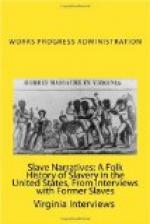Uncle Bob is tall and straight. He is blind. Was clean in appearance dressed in slightly faded overalls. He has a short, clean grey beard. He talks with a clear accent, no Negro accent. During Reconstruction days he served as County Clerk of Hempstead County under Carpetbaggar rule. During those days he was a political power to be reckoned with. He was a national as well as a state figure in the “Lily White Republican” organization. [His wife was a Negro, good looking, but showed little trace of much white blood.]
Interviewer: Mary D. Hudgins
Person Interviewed: Emma Sanderson
Home: 617 Wade Street, Hot Springs.
Aged: 75
“Emma Sanderson”—“Wade Street”. That was all the prospective interviewer could learn. “Emma Sanderson—ex-slave!” “Wade Street”—“Why it’s way off that way. You go sort of thatta way, and then thatta way.”
A city map disclosed no Wade Street. Maps belonging to a local abstractor helped not a whit. “Insurance maps are in more detail.” someone advised, “Wade Street,” mused the young woman at the desk, “I’ve heard of it. We have written a policy for someone there.” The head of the department was new to the city, but he was eager to help. After about five minutes search—from wall maps to bound volumes of blocks and back again it appeared that “Wade Street” more frequently known as “Washington Street” meanders wanderingly from Silver Street, in the colored section out to the “Gorge addition” inhabited by low economic level whites.
Down Malvern Avenue (Hot springs’ Beale Street) went the interviewer. On she went past the offices of a large Chicago packing house. For better then a block she trudged by dilapidated shops which a few seasons back had housed one of the key transient centers of the U.S.A. Down the street she walked, pausing for a moment to note that coffee colored faces decorated the placards in the beauty shop window—two well groomed mulatto girls sitting inside, evidently operators. Her course took her past sandwich joints and pool halls. Nails, she noted as she drifted along, had been driven into the projection beneath the plate glass window of the brick bank (closed during the depression—a building and bank built, owned and operated by negro capital) to keep loungers away. The colored theater (negroes are admitted only to the balconies of theaters in Hot Springs—one section of the balcony at the legitimate theater) she noticed was now serving as a religious gathering place. The well built and excellently maintained Pythian Bath house (where the hot waters are made available to colored folk) with the Alice Eve Hospital (45 beds, 5 nurses, 2 resident physicians—negro doctors thruout the town cooperating—surgical work a specialty) stood out in quiet dignity. For the rest, buildings were an indiscriminate hodge-podge of homes, apartment houses, shacks, and chain groceries. At the corner where “the street turns white” the interviewer turned east.




